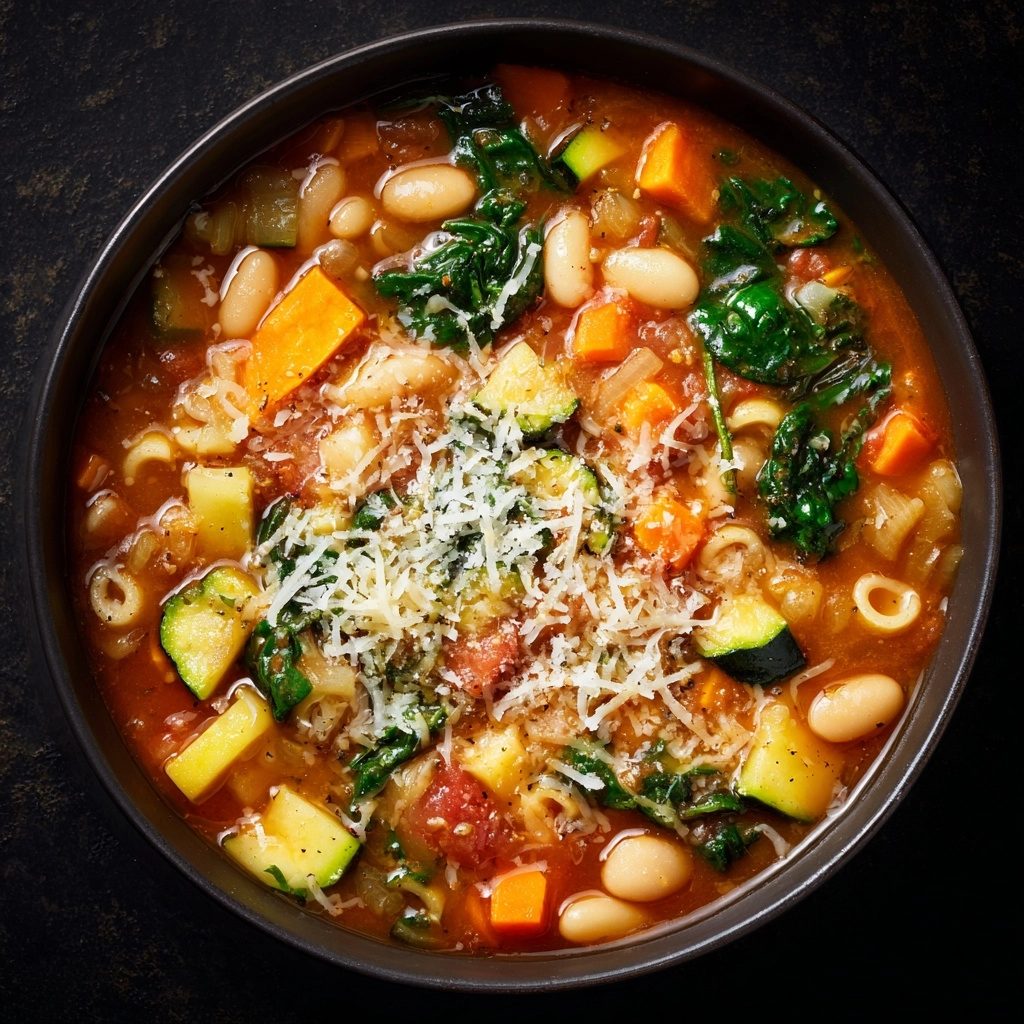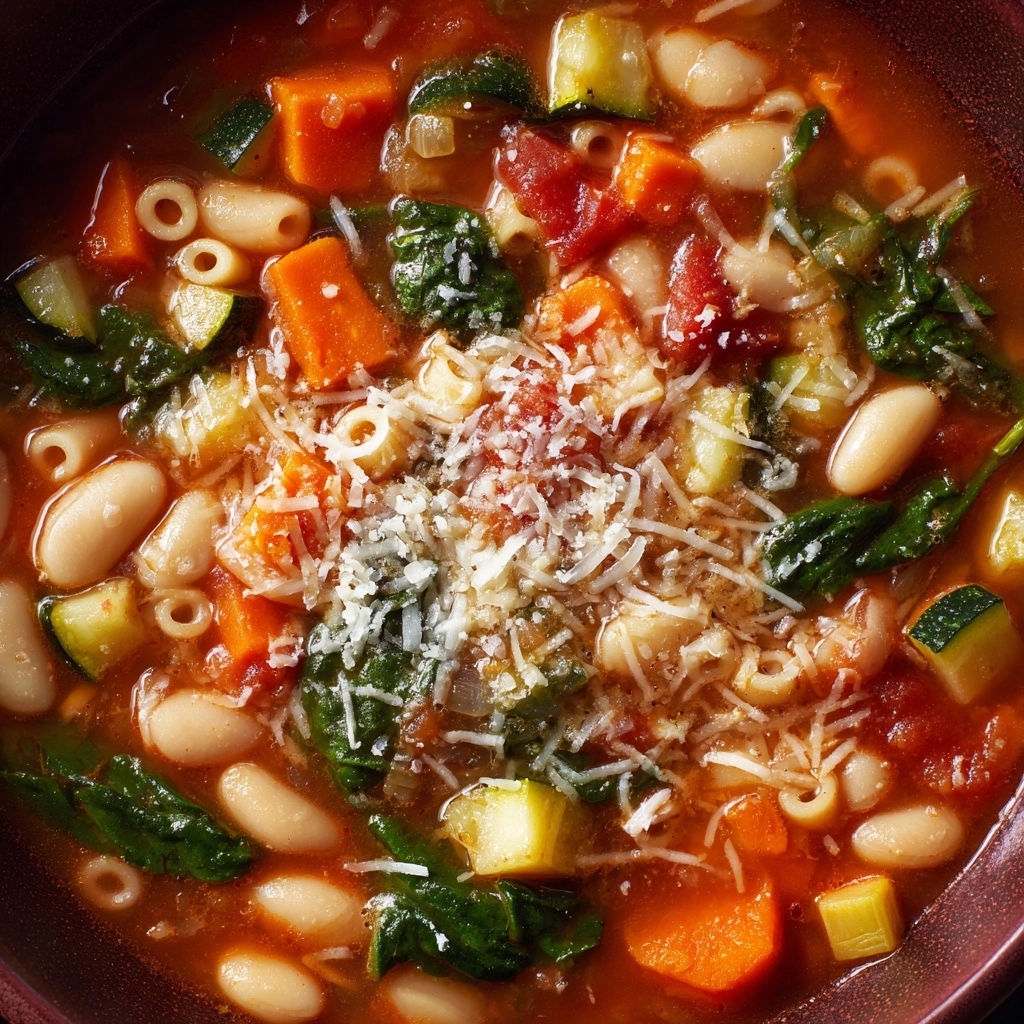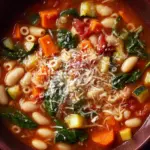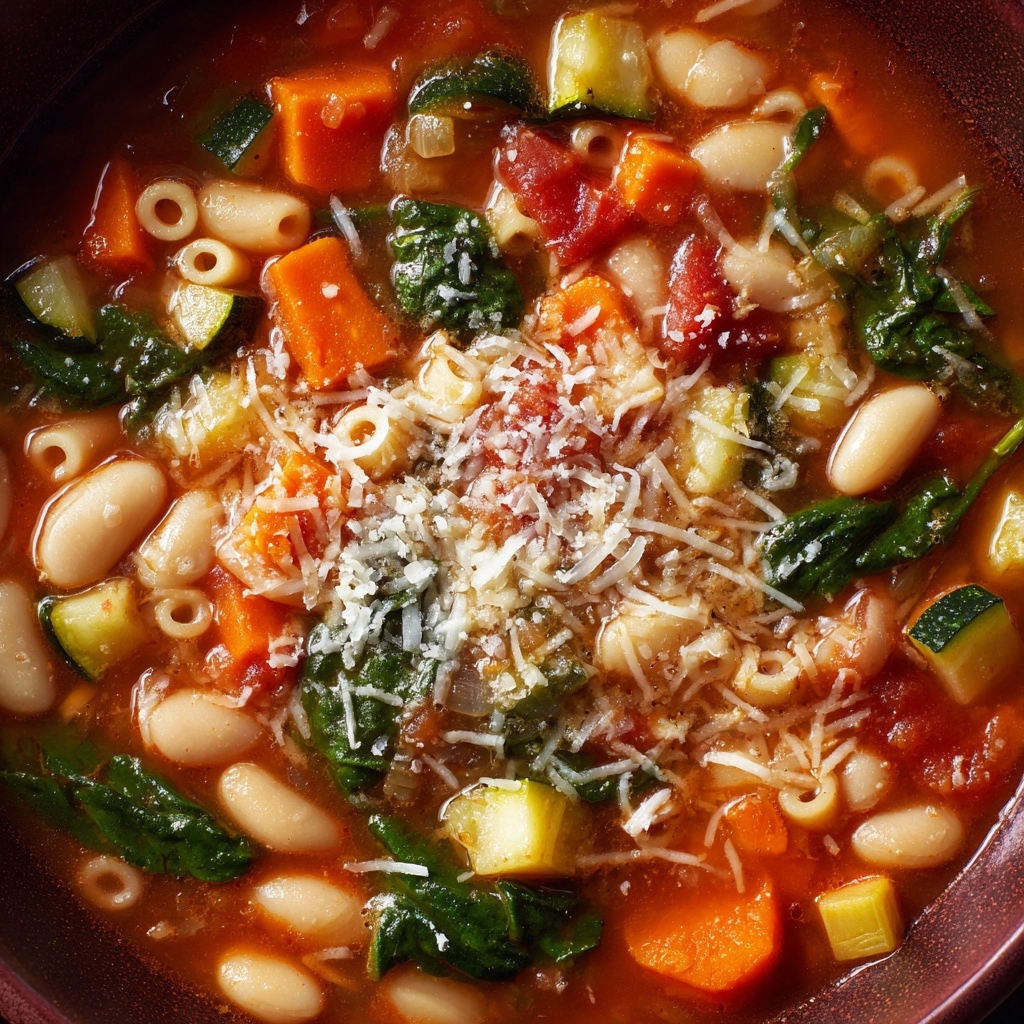A steaming bowl of Minestrone Soup is pure joy on a spoon. This Italian-inspired classic brims with colorful vegetables, hearty beans, tender pasta, and aromatic herbs—all simmered together in a savory tomato broth. It’s the ultimate comfort food that manages to be filling but never heavy, and it’s endlessly customizable. Whether you’re cooking for a crowd or just craving a nourishing weeknight dinner, Minestrone Soup delivers vibrant flavors and rustic goodness in every bite.

Ingredients You’ll Need
Minestrone Soup’s magic lies in its simple, humble ingredients—each one contributing color, texture, and depth of flavor. The variety of vegetables and beans means each spoonful is unique, and you probably already have most of the essentials in your kitchen!
- Olive oil: Adds a silky richness to sautéed veggies, building the foundation of the soup’s flavor.
- Onion: A diced onion brings gentle sweetness and aroma to the base.
- Garlic: Just a couple of cloves transform the broth with savoriness and warmth.
- Carrots: These add pops of color and a mellow, sweet note as they soften.
- Celery: Provides a subtle, slightly herbal crunch and depth to the soup.
- Zucchini: Softens delicately and gives the soup a light, springy texture.
- Green beans: Trimmed and chopped, they add crunch and a bright green hue.
- Diced tomatoes (with juice): The juicy tomatoes build body and tang into the broth.
- Kidney beans: These bring heft and a nutty flavor that melds perfectly with the veggies.
- Cannellini beans: Creamy and mild, they add protein and a lovely bite.
- Vegetable broth: The heart of Minestrone Soup, this delivers richness and big savory flavor.
- Water: Loosens the base and keeps things from getting too thick.
- Dried oregano: Infuses the soup with classic Italian earthiness.
- Dried basil: Scatters a fragrant, herby lift into every bite.
- Salt and black pepper: Essential for bringing out all the other flavors.
- Small pasta (ditalini or elbow): Pasta soaks up the broth and makes each bowl heartier.
- Baby spinach: Stirred in at the end, it wilts into tender, green ribbons throughout the soup.
How to Make Minestrone Soup
Step 1: Sauté the Aromatics
Begin by heating olive oil in a large soup pot over medium heat. Toss in your chopped onion, garlic, carrots, and celery. Sauté for about 5 to 6 minutes, just until these veggies are soft, fragrant, and glistening. This foundational step sweetens and deepens the flavor of the broth—and your kitchen will smell amazing!
Step 2: Add Zucchini and Green Beans
Stir in the chopped zucchini and green beans, letting them mingle and cook for another 3 to 4 minutes. This quick sauté gives the vegetables a head start and seals in their subtle flavors, keeping them vibrant and slightly crisp after simmering.
Step 3: Build the Broth and Simmer
Now, pour in the diced tomatoes (with their juices), kidney beans, cannellini beans, vegetable broth, water, oregano, basil, salt, and black pepper. Give everything a good stir to combine. Bring the soup up to a gentle boil, then reduce the heat. Let it simmer together for 10 minutes so the flavors can meld, and the house can soak in the scent of Minestrone Soup cooking.
Step 4: Add the Pasta
Stir in your small pasta of choice. Cook the pasta according to package instructions—usually 8 to 10 minutes—until perfectly al dente. The pasta absorbs the seasoned broth and gives the soup extra body, so be sure not to overcook.
Step 5: Wilt in the Spinach
Just before serving, stir in the baby spinach. Watch as the leaves wilt and turn a vibrant green within a minute. Taste the broth, then adjust seasoning to your liking—add a pinch more salt or a crack of black pepper if needed. Your Minestrone Soup is now ready to ladle into bowls!
How to Serve Minestrone Soup

Garnishes
A sprinkle of freshly grated Parmesan on top is the classic touch, melting just enough to add creamy, salty richness. You can also scatter over fresh basil ribbons or a swirl of good olive oil for even more flavor. For a little zing, a squeeze of lemon brightens everything up!
Side Dishes
Minestrone Soup pairs wonderfully with rustic, crusty bread to soak up the last bit of broth. If you’re feeling extra indulgent, try garlic bread or cheesy focaccia. For a light meal, add a crisp green salad dressed simply with olive oil and balsamic vinegar.
Creative Ways to Present
For a fun twist, serve Minestrone Soup in bread bowls or top with crunchy homemade croutons. Try ladling the soup over a scoop of cooked rice or barley for a heartier meal, or offer a “build your own” soup bar with bowls of toppings like pesto, chopped herbs, and shredded cheese for everyone to customize their bowl.
Make Ahead and Storage
Storing Leftovers
Let the Minestrone Soup cool completely, then store it in airtight containers in the fridge. It’ll keep beautifully for up to four days. You may notice the pasta absorbs some broth, so add a splash of water or extra broth before reheating if needed.
Freezing
Want to save Minestrone Soup for busy days? Simply let it cool, ladle into freezer-safe containers (leave some room at the top for expansion), and freeze for up to three months. Consider cooking and adding the pasta when you reheat—this keeps it perfectly firm.
Reheating
Reheat Minestrone Soup on the stovetop over medium heat, stirring occasionally, until hot throughout. If frozen, thaw overnight in the refrigerator before reheating, or gently warm from frozen on low, adding liquid as needed to loosen the soup.
FAQs
Can I use different vegetables in Minestrone Soup?
Absolutely! Minestrone Soup is perfect for using up whatever veggies are in your fridge. Try adding chopped bell peppers, potatoes, peas, or even a handful of shredded cabbage for extra variety.
Is Minestrone Soup gluten-free?
It can be! Just swap the regular pasta for your favorite gluten-free variety—there are plenty of options that hold up nicely in hot soup without getting mushy.
What’s the best type of pasta for Minestrone Soup?
Small shapes like ditalini, elbow macaroni, or small shells soak up the broth beautifully. You want shapes that won’t overpower the veggies but still provide a satisfying bite in each spoonful.
Can I make Minestrone Soup in advance?
Yes! Minestrone Soup actually tastes even better the next day as the flavors develop. Just keep in mind that the pasta will continue to soften, so you may want to cook it separately and add it fresh when reheating.
How can I make Minestrone Soup more filling?
Besides the beans and pasta, add an extra can of beans, more hearty vegetables like potatoes or butternut squash, or serve with a generous side of toasted bread for a truly satisfying meal.
Final Thoughts
If you’re searching for a meal that’s wholesome, hearty, and endlessly adaptable, give Minestrone Soup a try. It’s a bowlful of comfort and creativity, guaranteed to warm you up and win you over with every spoonful.
Print
Minestrone Soup Recipe
- Prep Time: 15 minutes
- Cook Time: 30 minutes
- Total Time: 45 minutes
- Yield: 6 servings
- Category: Soup
- Method: Stovetop
- Cuisine: Italian
- Diet: Vegetarian
Description
A hearty and comforting Italian vegetable soup, this Minestrone Soup is packed with nutritious ingredients like beans, vegetables, and pasta in a flavorful broth.
Ingredients
Vegetable Mixture:
- 2 tablespoons olive oil
- 1 small onion, diced
- 2 cloves garlic, minced
- 2 carrots, peeled and chopped
- 2 celery stalks, chopped
- 1 zucchini, chopped
- 1 cup green beans, trimmed and cut into 1-inch pieces
Soup Base:
- 1 can (14.5 oz) diced tomatoes with juice
- 1 can (15 oz) kidney beans, drained and rinsed
- 1 can (15 oz) cannellini beans, drained and rinsed
- 4 cups vegetable broth
- 1 cup water
- 1 teaspoon dried oregano
- 1 teaspoon dried basil
- 1/2 teaspoon salt
- 1/4 teaspoon black pepper
- 1 cup small pasta (like ditalini or elbow)
- 2 cups baby spinach
Instructions
- Sauté Vegetables: Heat olive oil in a large pot over medium heat. Sauté onion, garlic, carrots, and celery for 5–6 minutes until softened. Add zucchini and green beans; cook for another 3–4 minutes.
- Add Ingredients: Stir in diced tomatoes, kidney beans, cannellini beans, broth, water, oregano, basil, salt, and pepper. Bring to a boil.
- Cook Soup: Reduce heat to a simmer and cook for 10 minutes. Add pasta and cook according to package instructions until al dente, about 8–10 minutes.
- Finish and Serve: Stir in spinach until wilted. Adjust seasoning. Serve hot, optionally topped with Parmesan and crusty bread.
Notes
- For a gluten-free version, use gluten-free pasta.
- Add a Parmesan rind while simmering for extra flavor, discarding before serving.
Nutrition
- Serving Size: 1 bowl
- Calories: 260
- Sugar: 6g
- Sodium: 540mg
- Fat: 6g
- Saturated Fat: 1g
- Unsaturated Fat: 5g
- Trans Fat: 0g
- Carbohydrates: 40g
- Fiber: 8g
- Protein: 10g
- Cholesterol: 0mg








